
Written by Kitty Morse
Photographed by Owen Morse
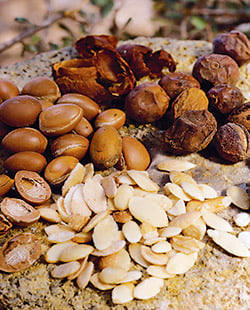 |
 |
| Argan fruits, like peaches or mangos, have an outer fleshy part that surrounds a hard shell that contains the seed. Once the seeds—the argan nuts—are extracted, the shells can be burned as fuel for cooking and home heating. Goats like to eat the fruits, but humans prefer to crush the seeds for their rich and tasty hazelnut-like oil. |
 iens voir mes chèvres!” (“Come see my goats!”) calls a shepherd boy to camera-toting tourists as they scramble down the steps of a brightly painted bus. For a few coins, he allows the photographers to click away to their heart’s content. Their subject: a score of nimble black goats perched meters off the ground among the gnarled limbs of a spiny argan tree.
iens voir mes chèvres!” (“Come see my goats!”) calls a shepherd boy to camera-toting tourists as they scramble down the steps of a brightly painted bus. For a few coins, he allows the photographers to click away to their heart’s content. Their subject: a score of nimble black goats perched meters off the ground among the gnarled limbs of a spiny argan tree.
Goats have long foraged in the parched landscape of the Souss plain in southwestern Morocco. Whenever edible plants are in short supply on the ground, the ruminants have learned to look—and climb—up to the leaves and olive-like drupes, or fruits, of the argan tree (Argania spinosa; also called “Moroccan ironwood”).
The local economy depends on the fruit of this endemic tree, which yields a prized and healthful oil rich in vitamins A and E and unsaturated fatty acids. With a lifespan of two centuries or more, the argan tree is of such value to the indigenous Berbers of the region that trees are often specifically included in legal lists of the assets of an estate.
The argan tree’s economic importance motivated Zoubida Charrouf, a chemist and researcher at Rabat’s Mohamed V University, to select Argania spinosa as the subject of her doctoral dissertation in 1984. She and her colleagues found that over the previous 20 years, the argan forest’s density had shrunk from 100 trees per hectare to only 30—that is, from 40 per acre to 12. The leathery-leafed botanical survivor from the Tertiary Epoch seemed headed for extinction. A severe drought that coincided with a dramatic increase in the region’s human population had led to overgrazing by both goats and camels, and thus to an upset of the region’s delicate ecosystem, in which the argan tree was a keystone species. Scientists predicted that this unique forest of more than 800,000 hectares (3088 sq mi) would shrink by as much as 40 percent by 2008. This would lead to diminished harvests and would probably spur the migration of rural families to already overcrowded cities.
The researchers joined with local officials to persuade the government to declare two percent of the argan forest off-limits to grazing. In 1998 UNESCO took up the cause and declared part of the argan forest—including the 54,000-hectare (208-sq mi) Souss-Massa National Park—an international Biosphere Reserve.
“Over two million people make their living directly or indirectly from the Argania spinosa. We had to motivate farmers to remain on the land,” says Charrouf. “One of the obvious ways was to build upon existing tradition and increase the scale of commercial production of argan oil. Since women are the keepers of tradition, the ones who have the ancestral know-how for producing argan oil, it seemed logical to turn to them first. Thus the idea of founding a women’s cooperative.”
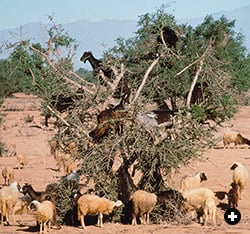 |
 |
| The oil and the forage they provide for nimble goats make argan trees vital to the livelihoods of some two million people. Drought, overgrazing and firewood collecting endanger the trees, which also serve as an ecological bulwark against the further expansion of the Sahara in Morocco. |
It took three years of lobbying to secure approval from national and local authorities to make Cooperative Amal (“hope”) a reality. In 1999, it opened in the village of Tamanar, 100 kilometers (62 mi) north of the cosmopolitan resort city of Agadir. It was the first establishment of its kind in Morocco.
The cooperative’s beginnings were less than auspicious for Charrouf and her financial backers, who included Moroccan businessmen, the British Consulate and Canada’s Centre de Recherches pour le Développement Inter-national. Local officials were skeptical of the all-women enterprise. And Berber men were reluctant to let their wives work outside the home. For this reason, the cooperative’s founding membership was composed almost exclusively of widows and divorced women. But as drought and economic pressure continued and the cooperative began to prove its value, many unemployed husbands came to count on their wives’ membership as a source of steady income for their families.
“A cooperative is often the driving force behind other improvements within a community—improvements to its infrastructure, healthcare delivery and schools,” says Charrouf. For this reason, some caïds [governors] who originally opposed cooperatives in their districts now encourage their development.”
In the beginning, Charrouf, Co-operative Amal’s manager, Khadija Rhalimi, and its elected president, Amina Edelcadi, faced what might diplomatically be called “a marketing challenge” to the international acceptance of argan oil: For centuries, farmers had gathered the argan nuts not directly from the trees, but from the ground, where they had been either expectorated or excreted by arboreal goats who had eaten the fleshy fruit. Charrouf is quick to point out that this archaic harvesting method is obsolete except on the most remote farms, and that all modern commercial enterprises like Cooperative Amal rely exclusively on tree-harvested fruit.
Women gather the drupes (afiash in Berber) and dry them in the sun. They separate the nut from the flesh (allig), then crack open the nut to recover the kernels within, which can contain up to 50 percent oil. These they roast, then grind to extract the oil. The nutshells are used as fuel for heating and cooking. The allig and the left-over oilcake from the ground kernels are shaped into patties called tazgamout and sold as cattle feed.
 |
 |
| In the Cooperative Amal in Tamanar, women crack argan-nut shells with round stones. It takes 15 to 20 hours—depending on skill—to crack enough nuts to produce a liter of oil. |
On a hot June morning, dozens of gunnysacks bulging with sun-dried argan fruits were piled high within Cooperative Amal’s cavernous warehouse and production facility. Seventy-eight-year-old Ijja Oubla, the cooperative’s oldest member, sat on a colorful straw mat astride a stone block. She processed the argan fruit while bantering with co-workers. A kettle of water for mint tea boiled nearby on the coals of a canoun next to Fatima Fakir, who, at 30, is Amal’s youngest member. Like Ijja, she is adept at cracking open each nut with a small, oval stone. Proof of her dexterity rests by her side: a large bowl filled with smooth, mahogany-colored kernels. Even so, it takes her 15 to 20 hours to accumulate the 2 1/2 kilograms (5 1/2 lb) of kernels required to produce one liter (26 fl oz) of argan oil.
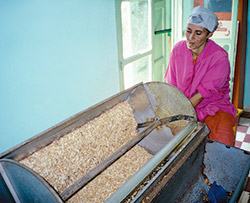 |
 |
| The nuts are then roasted before being pressed. The oil is filtered and bottled; the leftover oilcake is used as animal feed. |
The work is tedious, yet clearly a source of pride for Fakir and her 70 co-workers. But surely a machine could perform this task more quickly? Amina Edelcadi explains the rationale for perpetuating the manual operation.
“It’s simple. If we used purely mechanical means, these women would be out of a job. You have to remember that our main purpose is to provide employment for as many women as possible.”
Members of the cooperative earn around 35 dirhams a day (about $3.50), depending upon production. Some industrious workers receive as much as $75 a month. (Morocco’s average gross national income per person is about $99 a month.) At the end of the year, all members share in Cooperative Amal’s profits.
Fakir breaks into a broad smile when asked how the Cooperative Amal has changed her life. “My husband likes the fact that I bring home some money, and my pay allows me to send our daughter to school. It also gives me the chance to attend literacy classes.”

“At my age, I like not having to depend on anyone,” chimes in the venerable Oubla.
Earning an income is important, but so is the development of each woman’s self-esteem. “When I see a woman walking along the side of the road wearing new clothes, accompanied by her equally well-dressed children, I know she must belong to the cooperative,” says Charrouf.
She is also proud of Cooperative Amal’s effect on local society. “Every day, I see the positive impact of cooperatives. Let me tell you a story,” she says, brushing back a lock of hair from her face. “A governor wanted to dump his town’s garbage in a nearby stand of argan trees. The local women banded together and picketed with signs that read ‘Touchez pas à ma forêt!’—‘Don’t touch my forest!’ The national media caught wind of the story, and the caïd had to relent!”
Cooperative Amal does make a few concessions to modernity: a gas-fired roasting drum and electric machines for pressing the kernels and filtering the oil. In addition, it employs nitrogen gas infusion in the bottling process to delay oxidation of the argan oil and extend its shelf life. A traditional processing implement, a hand-turned granite quern called a raha, is on display in the cooperative’s foyer. One just like it is still in use in Casablanca’s Marché Central, but it is mainly for the benefit of tourists.
The members of Cooperative Amal de Tamanar grind almost 200 kilograms (440 lb) of kernels every week, and annually they produce 10,000 liters (2640 gal) of argan oil. Most is for domestic consumption, but some is shipped to specialty stores in Europe, Canada and the United States. To bring argan oil to the attention of the global market, the cooperative has set up a Web site.
In October 2001, Cooperative Amal received a special jury award from the prestigious international Slow Food Association, a group that promotes respect for traditional and ecologically sound methods of food production.
Success and international recognition inspired other communities within the argan forest. A discreet sign lures visitors to another cooperative, Cooperative Ajdigue (“argan blossom”) in the village of Tidzi, 60 kilometers (37 mi) south of Essaouira. Inside, Samira Anjar and a colleague apply attractive labels to bottles of argan oil, to decorative jars of argan-based lotion and face cream, and to containers of an aromatic and delicious Nutella-like concoction of ground almonds, honey and argan oil called amlou.
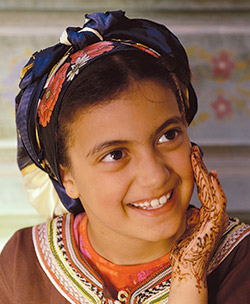 |
 |
| Argan oil from unroasted seeds is a popular cosmetic, said to be useful for dry skin, wrinkles and blemishes. |
Like its counterpart in Tamanar, Cooperative Ajdigue received financial assistance from both national and international sources. It markets its oil in Morocco, Holland, Germany and France.
In Essaouira, along Morocco’s coast, Jean-Claude and Evelyne Dulac, together with Mohamed Kabbaj, own the internationally renowned Dar Loubane restaurant. They are ardent aficionados of argan oil. They use it, as well as amlou, to enhance many of the dishes featured in their elegant 18th-century riyyad, or courtyard guest house, inside the walls of Essaouira’s picturesque city center.
“Try a teaspoon of amlou on a warm baghrir,” Evelyne coaxes, showing the leavened pancake to patrons. “C’est délicieux!”
Diners discern the oil’s light, hazelnut-like flavor in a number of dishes, from a vibrant salad of charcoal-grilled red bell peppers and marinated anchovies to a sumptuous tagine (stew) of chicken and dried apricots.
“Essaouira’s cooks like to sprinkle argan oil over a dish of steamed couscous,” Evelyne adds. “I often fry eggs in the oil before seasoning them with a little cumin. Our foreign patrons love it.”
Moroccans treasure their argan oil for its pharmaceutical and cosmetic uses as well, for which oil is extracted from unroasted kernels. It is said to cure juvenile acne and rheumatism, and its high content of linoleic acid makes it a popular hair conditioner and nail fortifier, notes Charrouf—who is also president of Morocco’s Ibn al Baitar Association for the study of medicinal plants. She believes the discovery of further medical applications for argan oil is only a matter of time.
In 2003, Charrouf organized GIE Targanine, a legally recognized umbrella organization comprising four cooperatives, each with its own director and its own marketing program. She hopes to see 30 more cooperatives open by the end of 2005.
“At this rate, we may even create enough work to employ a few men!” she says with a laugh.
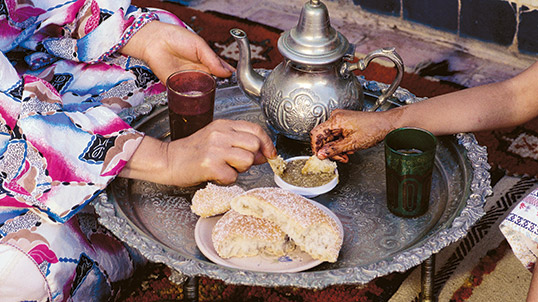 |
 |
| Amlou is a richly tasty mixture of ground almonds, honey and argan oil. Scooped onto fresh bread and served with mint tea, it makes a delicious and traditional breakfast. |
 |
Kitty Morse (www.kittymorse.com) was born in Casablanca and lives in California. Author of nine cookbooks, she leads an annual culinary tour to Morocco. |
 |
Photographer Owen Morse illustrates his wife’s books. His work most recently appeared in Saudi Aramco World in the March/April 2002 issue. |